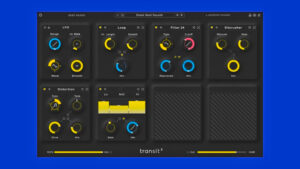Baby Audio is known for making affordable and high-quality plugins, including a bunch of analog-style tools and creative VSTs. Their latest release, Transit 2, is a multi-effect plugin made in collaboration with musician, producer, and content creator Andrew Huang. I’ve been checking it out lately, and it’s designed to add smooth transitions and cool glitch effects to your audio.
Transit 2 builds on the original version, adding advanced features that make it even more powerful and flexible. In this article, I’ll walk you through its key features, the types of effects it includes, and how you can use them in your own projects.
Detailed Overview
Expanded Motion Modes
Baby Audio Transit 2 includes five motion modes allowing users to control transition effects dynamically. These modes were not available in the original Transit. The motion modes are as follows:
- LFO (Low-Frequency Oscillator): This feature uses waveforms like sine, triangle, saw, and square waves to rhythmically manipulate parameters. It is commonly applied in reverb and bass kick effects. The LFO section offers options for synchronization and smoothing, providing users with various waveforms to enhance their sounds.
- Envelope Follower: This mode adjusts effects based on the audio signal’s amplitude, creating transitions that respond to the music.
- Sidechain: A widely used effect for sound layering, a sidechain is particularly useful when combining two sounds with similar frequencies.
- Gate: The gate effect silences sound when its amplitude falls below a certain level. This method has been a staple in audio cleansing techniques. The gate feature includes duration control, pendulum options, and looping capabilities.
- Sequencer: This mode syncs transitions to the DAW’s grid for precise timing.
- Loop: This function generates rhythmic stutter effects that can be synchronized or freely set, adding texture to tracks.
- Reverser: This is also an important effect in sound design. As the name suggests, it reverses the audio signal.
The sidechain and envelope follower features also include attack, release, range, and sensitivity controls, which I found make Baby Audio Transit 2 a lot more flexible compared to the original version.
Preset Library:
Nowadays, every plugin has presets, which are convenient for finding its capability. This baby audio plugin has 838 presets designed by Andrew Huang and his collaborators.
Creative Applications:
This multi-effect plugin has many applications in the music industry. It can be used for sound design, such as EDM drops and other soundscapes, and much more.
First Look Review:
I’ve personally spent some time using this plugin, and in this part of the blog, I’ll share my honest thoughts on it. Before getting into my review of the Baby Audio Transit 2 VST, I just want to make one thing clear — this review is only meant to inform you, not to promote the plugin or the company behind it. Here’s my breakdown of the pros and cons.
Pros:
- The plugin now includes six new motion modes, such as the LFO, side chain, gate, etc. None of these modes were present in the first version of this plugin. This adds a sense of advancement, a plus point compared to its earlier version.
- With 28 effects modules (including ten new additions like Warp, Reverser, and Analog Chorus), this plugin is a comprehensive toolkit for sound design. Producers can experiment with different textures without opening several effect plugins on the screen.
- The UI of this plugin is very user-friendly, which avoids the sub-menus and other complex options.
Cons:
The plugin can be a great choice for producers and sound designers, though some users (including me) feel the price is a bit on the higher side. If you accidentally tweak a knob and forget its original spot, you’re stuck—Transit 2 doesn’t include multi-step undo, so you can’t easily backtrack your changes.
When you open several instances in one session, this VST can hit your CPU pretty hard, causing stutters or lag. The interface looks nice and modern, but on lower-end PCs or laptops without a dedicated GPU, the GUI can get sluggish.
In my larger sessions, I’ve also noticed that Transit 2 takes a little longer to load compared to other effect plugins, which can slow down project recall. Plus, automation on multiple macros sometimes feels choppy, jumping instead of moving smoothly.
Some Alternatives to this VST:
- MeldaProduction MXXX
- Unfiltered Audio BYOME
- Kilohearts Multipass
- Soundtoys Effect Rack
- Devious Machines Infiltrator 2
- Sugar Bytes Graindad
- Eventide H3000 Factory
- iZotope Stutter Edit 2
- Arturia FX Collection
- Valhalla Supermassive
- Waves Studio Rack
- D16 Group’s Toraverb 2
- FabFilter Pro-R
- Slate Digital Virtual Mix Rack
